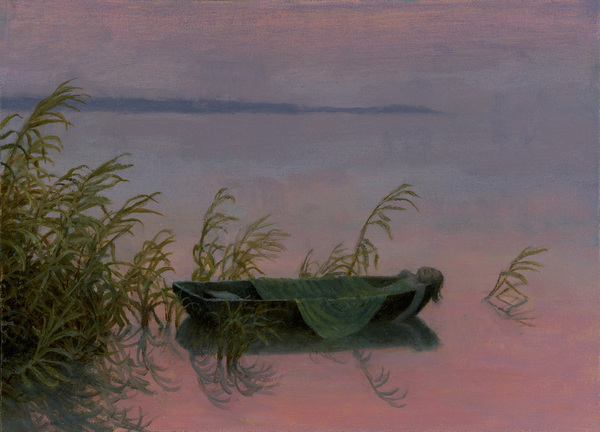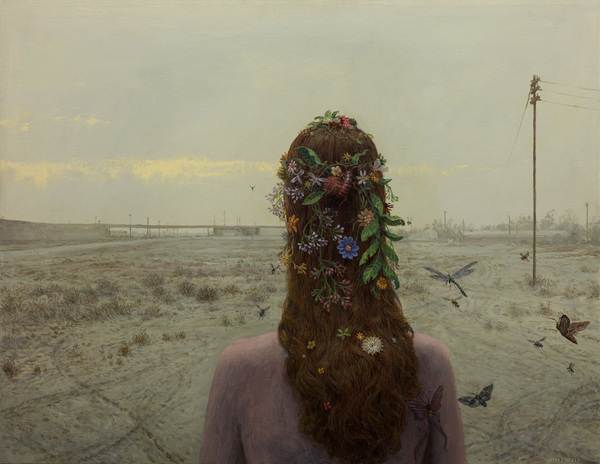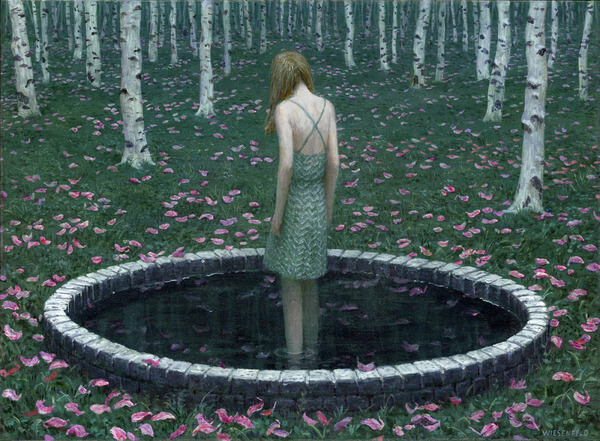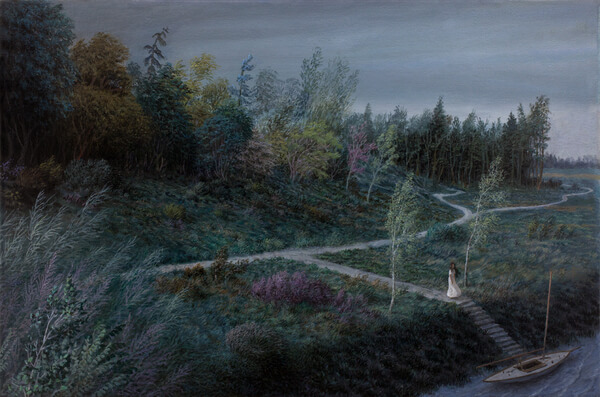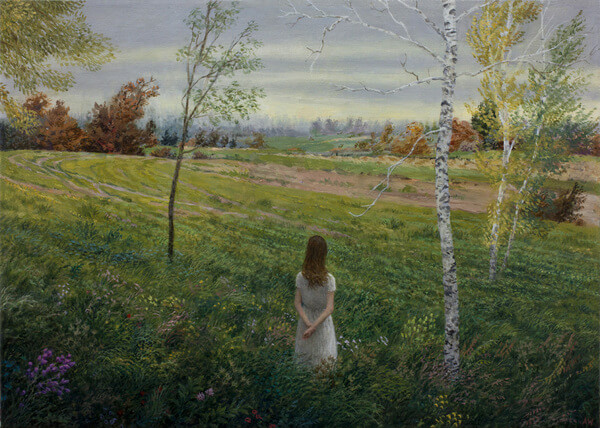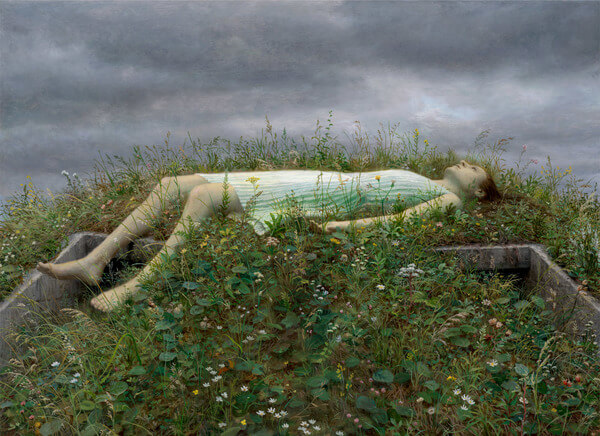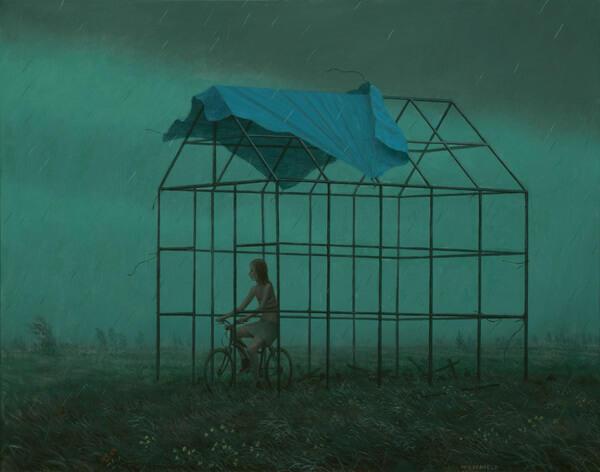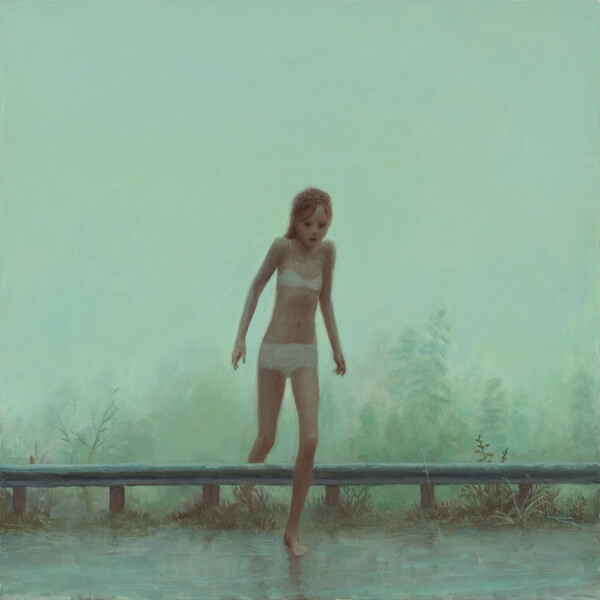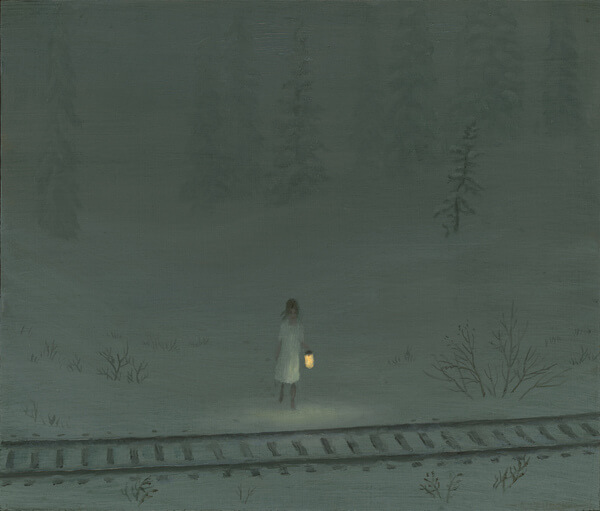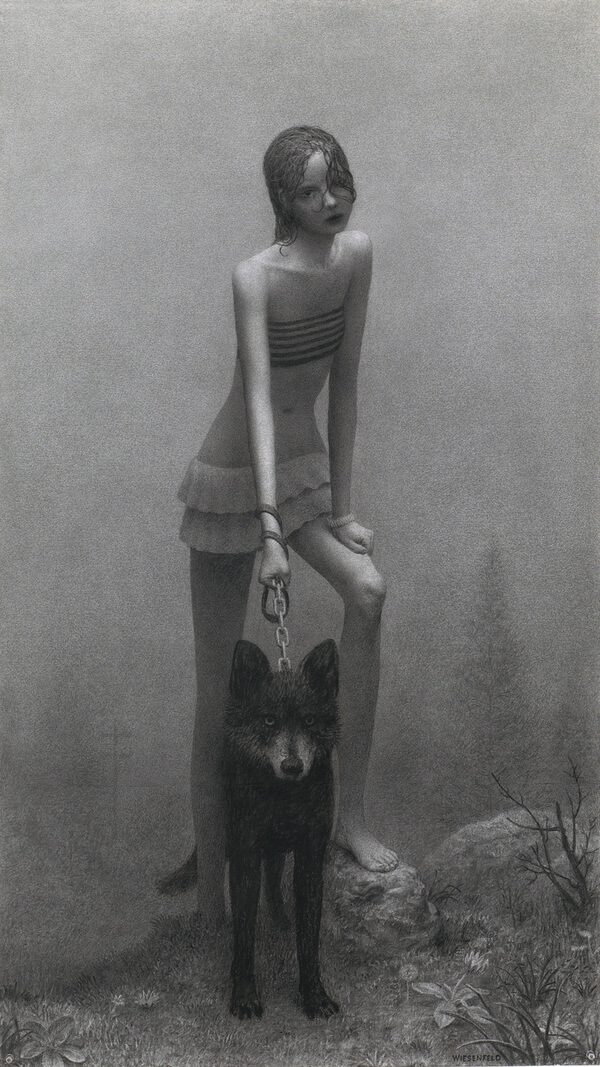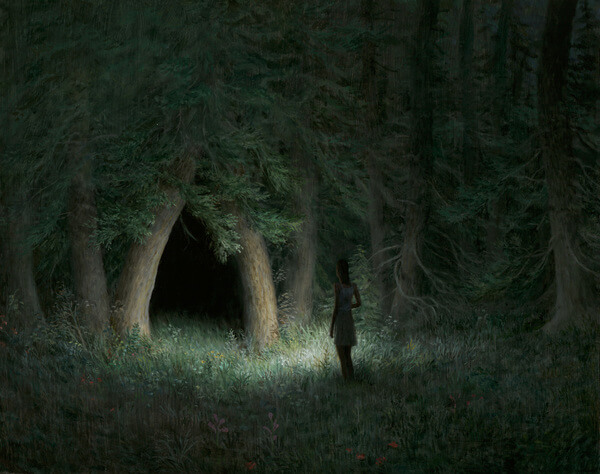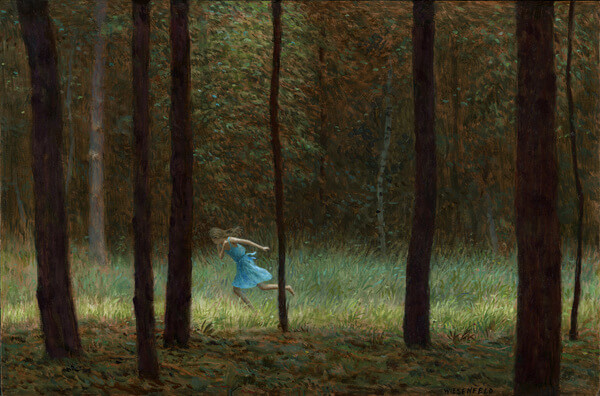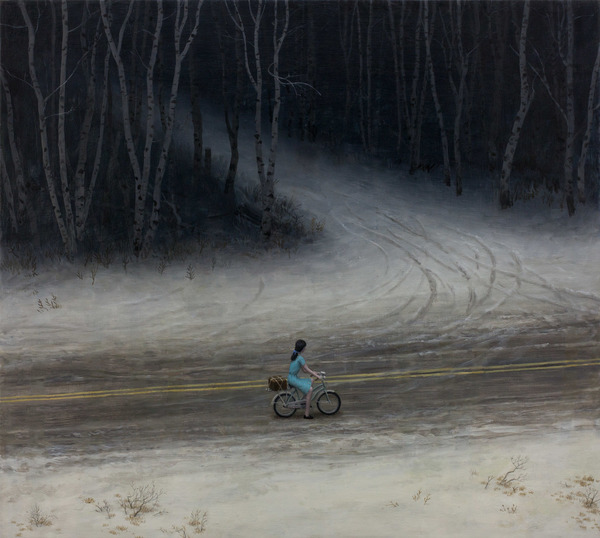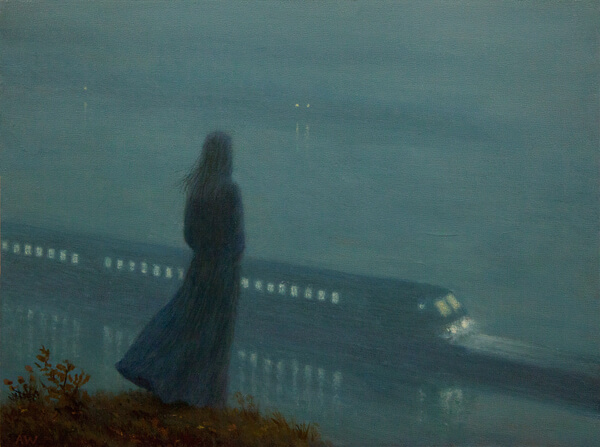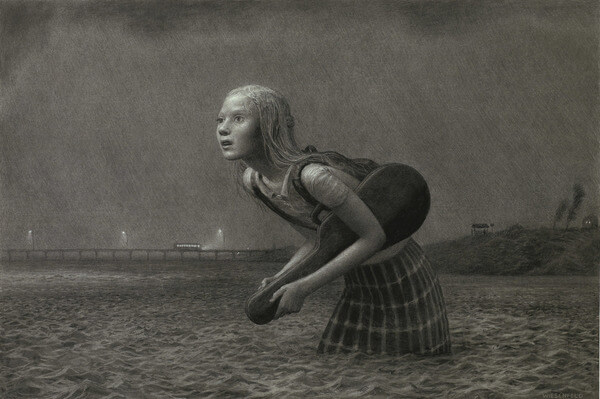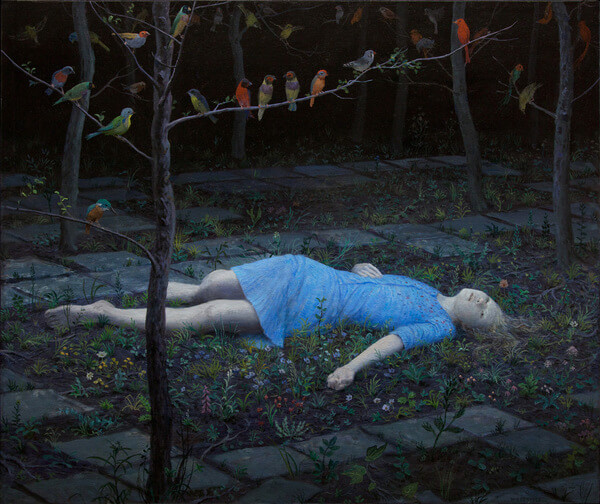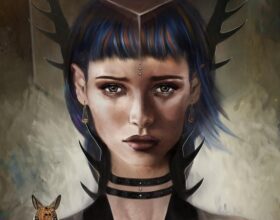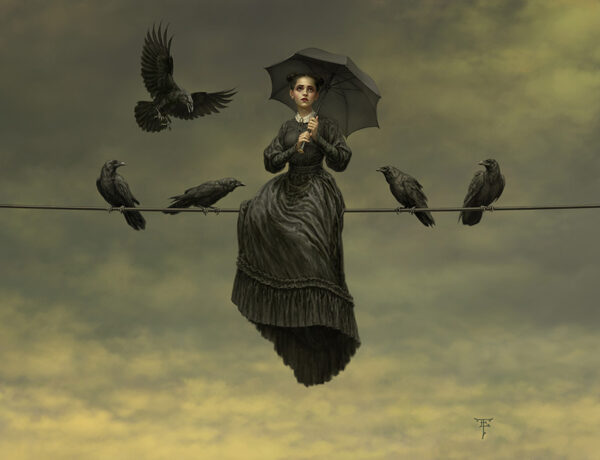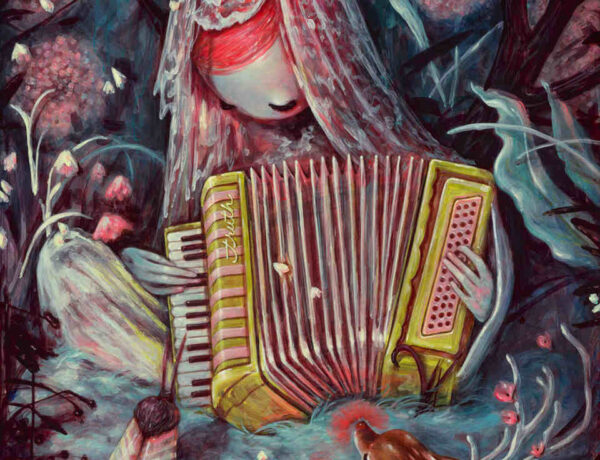Looking at Aron Wiesenfeld’s paintings is akin to waking up from your dream. There’s a fogginess about what you’ve just experienced, and what you’ve just felt, but it stays there in the abyss within you – heavy and ever-present as the morning wears on. There remains a taste of the past in your thoughts, and the suppressed urge to walk on into the horizon, as you had once fantasised as a child. It’s the feeling of wanting to stay inside your dream a little longer.
Aron Wiesenfeld is an American artist who resides in San Diego, California. His paintings are stories that commonly feature mysterious heroines, characters that are both magnetic in their command of presence and poetic in their vulnerability. His scenes are often sparse natural landscapes, on the outskirt borders where the wilderness and urban converge. There is such an internal movement within his works, from the stormy winds that bend the trees to the huddled walk of his painted people who are in the midst of their journeying.
Sometimes in his paintings, there appears to be a path beyond; a darkened road, cave or tunnel that the character is looking toward. There’s no indication as to whether the character will take this road. But still, it is there and strangely compelling. I think we all want to take that empty, eerie road, but, like some of the characters, we exist only on the verge. His paintings should be considered as a whole, as he seems to weave scenes together spaces, characters and time within his collections. Working mostly in oil, Aron is a creator of small moments that contain a large resonance with the emotions and memories of each and every viewer. These are the moments of life that occur in the small hours, the things we never see and the things we’ll never know if we aren’t out there looking for them.
Read on to hear from Aron Wiesenfeld, a great storyteller himself…
Hi Aron. Your paintings can be described as portraying somewhat desolate, lonely characters. Is this in tune with your understanding of your paintings or do you see a more inherently hopeful outlook?
I don’t think of them in terms like hopeful or lonely. An image makes an emotional connection or it doesn’t. Some people have said my paintings are depressing. I just think that means it didn’t resonate with them; there was nothing there for them. It’s like music, if it really gets to you, there are no words for it. One could say a song is sad, but if a song truly connects, you don’t feel sadness at all, kind of the opposite. But even then it’s really hard to put that emotion into words.
There seems to be a theme of journeying in your works. Trains, tunnels and railways are prominent motifs. Describe what ‘the journey’ means to you and the way you approach art-making.
A central theme in my work is a sense of having lost one’s home, and there is either a restless searching for a replacement of that, or rejection of it in favor of a quest. The tunnels and train tracks, as well as greenhouses and neglected cars, are things that help me tell those stories. They can mean different things depending on the painting. For example, sometimes they are our bridges to the past, or memories. Other times they represent something unattainable, or a leap of faith, or starting a journey with an unknown destination.
Where do you find inspiration for the landscapes within your work? You seem to repeat scenes throughout your collections. Are these real places?
The paintings are often based on real places, but filtered by my memory of them. My process usually involves a lot of sketching and re-sketching, so if something was based on a real place it might be unrecognizable by the time the painting is done. I have to “digest” things in that way in order to make them my own. I feel that way about everything in the paintings.
I’ll take inspiration wherever I can find it. I obsessively keep my eyes out for ideas. For example, movies, novels, and scenes outside train windows have been among the more fruitful sources of inspiration.
Following on, your landscapes often depict the meeting of natural and urban elements. Does the natural world shape the way you approach art? And do you find the urban, constructed world an infringement on nature or as becoming a part of it?
Those boundary places between the natural and man-made have played an important role in my work, particularly because they are away from things that anyone cares about or notices. They are purely utilitarian and no thought was ever given to how they look. I think it’s interesting to set stories and people in those places, and see what it means for the narratives and the characters.
Your work reminds me of Magical Realist worlds, dreamy landscapes with almost anime-like abstraction. What kind of artistic and/or cultural movements do you accredit to your art-making?
I’d have to say the Romanticism era has inspired me most. Around 1820 to 1850, right before impressionism, was clearly a very special time. So much great artwork was created in those few decades. Though the romantic era painters are hard to group together, or even call it a movement. By the nature of the age, they were a group of idiosyncratic individuals, working in different countries, whose only commonality was their concern with their subjective emotional reactions to the world.
I don’t see myself as belonging to any particular art movement. Political issues do come into my work, even though I’m not consciously trying to do it.
Particularly in the collection Shelter, you utilise light and shadow very effectively. And many of your paintings are set in dim or nightly moments. Do you actively seek to contrast the darkness from the lightness in your paintings?
I was mainly concerned with a certain mood in those paintings. A lot of the inspiration for them came from nocturnal scenes in Japanese woodblock art.
I think this quote from Edward Burne-Jones describes my own aspirations, “I mean by a picture a beautiful romantic dream of something that never was, never will be – in a light better than any light that ever shone – in a land no one can define, or remember, only desire.”
I’m interested in how personally you attach yourself to your paintings. Do you find yourself within your paintings? Or do you distance yourself from the subject matter?
I do see myself in them, though it’s often a part of myself I don’t fully understand, or I’m surprised to find it there. I think the reason for that is the way the paintings are created, which is that they are constructed bit by bit, from thousands of small decisions. Those decisions are made intuitively, without conscious thought.
Is there something new as an artist you are exploring or would like to explore in the future? For example: is there a medium or form you would like to experiment with?
Lately, I have been revisiting to my comic book roots. I started my professional life in comics, and my first artistic interest as a kid was comics. I’m working on a graphic novel that is based on a drawing I did a few years ago. It’s been a lot of fun to come back to the medium after 20 years, like getting reacquainted with an old friend.
A central theme in my work is a sense of having lost one’s home…
A studio question: Describe how and where the magic happens.
I work in a smallish room, with a window on the north wall. I work standing most of the time. There is not much furniture, just a desk, an easel, and a bookcase. I usually don’t listen to anything while working because I find it distracting. I work about 8 hours a day, but take a lot of breaks.
Tell us the future: what’s on your horizon, art-related or otherwise?
There are a few things coming up that I’m excited about. In addition to the graphic novel, there will be a new art book coming out, which will consist of artwork done in the last 5 years or so, including a lot of things never published anywhere. Also, I will have a gallery show of new paintings in the fall of 2020.
Aron Wiesenfeld Social Media Accounts
Website | Instagram | Facebook
Related Articles
Anne Juul Christophersen: Forgotten Connections of Childhood Dreams


